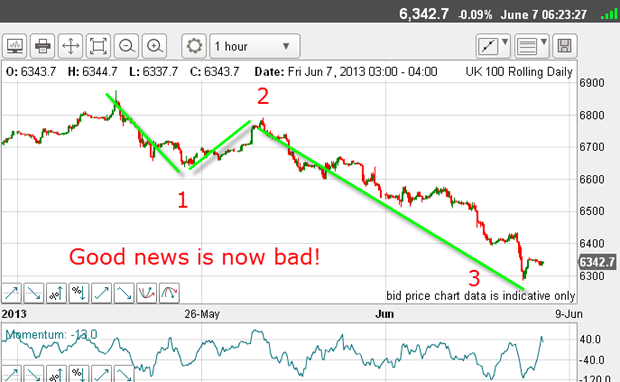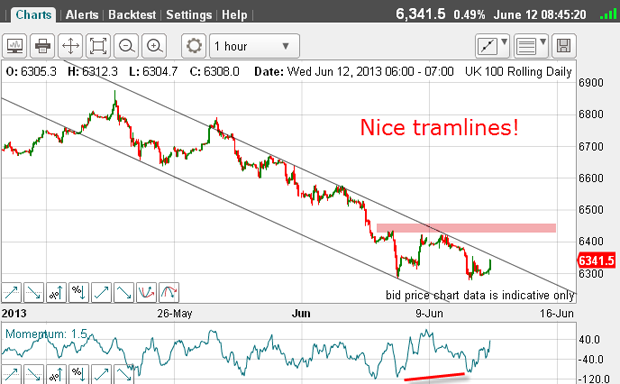How to take profits in the FTSE
Knowing when to take profits - and not miss out on potentially bigger profits - is one of the hardest dilemmas traders face. Here, John C Burford explains one strategy that lets you have it both ways.
With downward pressure on shares continuing, the best thing a short-term trader can do is to look for a good exit strategy for their short-term positions.
Just as in long-term trading, where market turns are accompanied by sentiment extremes, taking short-term profits on your shorts is best when short-term sentiment is bearish.
And you can get a feel for this just by reading the financial mainstream media. Recently, comments have turned against commodities with gold at the forefront and since the FTSE index is filled with commodity producers, naturally, sentiment has turned sour on it.
MoneyWeek
Subscribe to MoneyWeek today and get your first six magazine issues absolutely FREE

Sign up to Money Morning
Don't miss the latest investment and personal finances news, market analysis, plus money-saving tips with our free twice-daily newsletter
Don't miss the latest investment and personal finances news, market analysis, plus money-saving tips with our free twice-daily newsletter
And the FTSE has offered a great example in how to spot clues which can provide good exit points.
When to take short-term profits

Naturally, this wave 3 will not go on forever, and if a short entry was made near the wave 2 high, substantial gains are being accumulated, which a short-term trader should not let get away!
The question is this: How can I tell when the wave 3 has turned into a wave 4 up?
Let's take a look at the hourly chart since then (below).
The market hit the round-number 6,300 level last Thursday, then rallied to my upper tramline and yesterday, fell back to the 6,300 level.
But in so doing, it created a positive-momentum divergence (red bar). To me, this was a good enough clue to take a short-term profit of around 400 pips.

And as I write this morning, the market is rallying up to my upper tramline once more.
The odds are growing that we are in the early stages of a wave 4 up with the wave 3 low in place.
As the whole world and his dog knows, stock markets are heavily influenced by what investors/traders believe the Fed's actions will be.
To taper or not to taper that is the question.
Up to the 22 May stock market highs, opinion was certain the Fed would continue with its quantitative easing (QE) stimulus for the foreseeable future, since the macro economic data was on the weak side. This produced the absurd situation that bad news was actually good. But we have seen a big correction off the 22 May high as opinion leaned towards the Fed actually reducing its QE programme in the near future.
But now that sentiment has turned negative towards stocks, it is highly likely that opinion will switch back yet again!
That means stocks will possibly rally above my tramline into the resistance area of the pink zone.
So the trader has a dilemma. Do you exit all your positions at once say near the 6,300 level?
The problem is that the market may decide to move below this level and go on to make new lows, and you would be missing out on extra profit and possibly kicking yourself into the bargain.
My split bet strategy
split bet strategy
Let's say I entered a short trade at the 6,700 level and bet two pips a point (or a multiple).
One of the pips I will trade short-term and the other I will trade longer-term.
I have taken a profit at the 6,300 level but only on the first pip. This gives me a banked profit of 400 pips.
But I still have the other pip working! That is when I can move my protective stop to break-even. I will let the market decide what happens to this trade.
The worst case scenario is that I make 400 pips on the first trade and nothing on the second.
The best case is that I make 400 on the first and more than 400 on the second.
This is a good situation to be in and avoids the frustration of seeing the market sail on without you being on board.
Of course, there are many variations on this theme and I encourage all of you to explore the best options for yourselves.
Get the latest financial news, insights and expert analysis from our award-winning MoneyWeek team, to help you understand what really matters when it comes to your finances.
John is is a British-born lapsed PhD physicist, who previously worked for Nasa on the Mars exploration team. He is a former commodity trading advisor with the US Commodities Futures Trading Commission, and worked in a boutique futures house in California in the 1980s.
He was a partner in one of the first futures newsletter advisory services, based in Washington DC, specialising in pork bellies and currencies. John is primarily a chart-reading trader, having cut his trading teeth in the days before PCs.
As well as his work in the financial world, he has launched, run and sold several 'real' businesses producing 'real' products.
-
 London claims victory in the Brexit wars
London claims victory in the Brexit warsOpinion JPMorgan Chase's decision to build a new headquarters in London is a huge vote of confidence and a sign that the City will remain Europe's key financial hub
-
 Rachel Reeves's Autumn Budget: What it means for the UK
Rachel Reeves's Autumn Budget: What it means for the UKOpinion A directionless and floundering government has ducked the hard choices at the Autumn Budget, says Simon Wilson